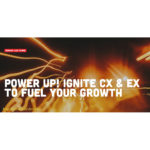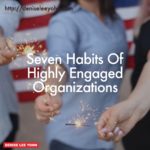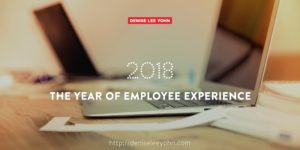2018 Will Be the Year of Employee Experience
Now that according to Gartner more than 90% of businesses compete primarily on the basis of customer experience (CX), it’s no longer enough to make CX a corporate priority. The next competitive frontier is employee experience (EX) and the signs indicate so strongly that EX will become the next priority for organizations that I’m calling 2018 The Year of Employee Experience.
What Is Employee Experience?
Before I get into why EX will be the preeminent corporate priority this year, let me clarify what EX is. Since CX is the sum of all interactions a customer has with a company, then:
EX is sum of everything an employee experiences throughout his or her connection to the organization — every employee interaction, from the first contact as a potential recruit to the last interaction after the end of employment.
Importantly, EX is not:
- New and improved HR — While HR shapes some of the most critical interactions within EX (recruiting, on-boarding, performance reviews and planning), EX involves so much more — including interactions that are usually the domain of facilities, corporate communications, and IT.
- Perks and parties — “Feel good” tactics such as free gym memberships and foos ball tables in the break room are simply that: Your EX may end up including such tactics, but EX is a strategic initiative whose aim goes well beyond making employment more fun and enjoyable. EX involves designing and delivering distinctive experiences for employees that are aligned with your desired culture.
- Employer or employment branding — To compete in the war for talent, many companies try to develop a external reputation to help improve their recruiting efforts, but EX is about the day-to-day experiences an organization provides to existing employees.
- Treating employees as customers — Although CX does provide a model for defining and understanding EX, a very different type of relationship and value proposition exists between employer and employee vs. brand and customer, so thinking about employees as customers is an incomplete approach.
- Employee engagement — Employee engagement — that is, employees’ commitment to your company and their jobs — is the end goal while EX is the means to that end. Too many companies only pay attention to the results from annual employee engagement surveys and don’t proactively design and manage EX to produce better engagement.
Mark Levy, former head of Employee Experience at Airbnb, provided me with an apt description of how his company defines EX: “Anything that sets employees up for success or improves our culture should be a part of EX.”
Why is Employee Experience Important?
Several workforce factors have raised the importance level of EX. First, many businesses currently operate in sectors where a war for talent rages. Whether it’s retail, high-tech, or jobs whose need for highly specialized skills is not matched by adequate compensation such as nursing and airline pilots, it’s getting harder for many employers to attract and retain talent. Henry G. Jackson, CEO and president of the Society for Human Resource Management, says, “The skills shortage is an ever-present challenge.” Offering a superior EX can give employers a competitive advantage in attracting recruits to them and then engaging them in ways that encourage them to stay with their organizations.
The popularity of websites including LinkedIn and Glassdoor make it much easier for prospective employees to assess the daily EX at a company they’re considering. No longer can companies hide behind employer branding campaigns or rely on skillful recruiters to position themselves among recruits. In fact, a sense of consumerism now pervades the recruiting process. Just as customers pick and choose from a plethora of brands based on reviews they access digitally, many people seem to use online resources to “shop” among potential employers — and decide to proceed with those companies that offer the kind of EX they’re looking for.
Also a new social contract between employee and employer is emerging, says a report by Deloitte. The stability that once characterized the best employee-employer relationships is being disrupted by employees’ tendency to change jobs more frequently and other factors. Therefore, “employers must provide development more quickly, move people more regularly, provide continuous cycles of promotion, and give employees more tools to manage their own careers,” the report concludes. Your efforts, they say, must be oriented around the different needs and expectations that today’s employees have. Adopting EX as a strategic priority enables you to do just that.
What Results Does Employee Experience Produce?
If you prioritize EX, you’ll be one of a growing number of companies discovering the power of EX to positively impact business performance in many areas. Research by Jacob Morgan, author of The Employee Experience Advantage, shows that organizations that invested most heavily in EX were:
- included 11.5 times as often in Glassdoor’s Best Places to Work
- listed 4.4 times as often in LinkedIn’s list of North America’s Most In-Demand Employers
- 28 times more often listed among Fast Company’s Most Innovative Companies
- listed 2.1 times as often on the Forbes list of the World’s Most Innovative Companies
- twice as often found in the American Customer Satisfaction Index
Most importantly, he finds that “experiential organizations had more than 4 times the average profit and more than 2 times the average revenue. They were also almost 25 percent smaller, which suggests higher levels of productivity and innovation.”
2018 The Year of Employee Experience
I’m excited and encouraged by the focus that is now being put on EX — and I plan to report throughout 2018 on companies that are using EX to increase not only employee satisfaction, productivity, and retention, but also brand equity, competitive advantage, and sustainable growth. If your organization has adopted EX as a strategic priority, let me know using the Comments section below.
related:



